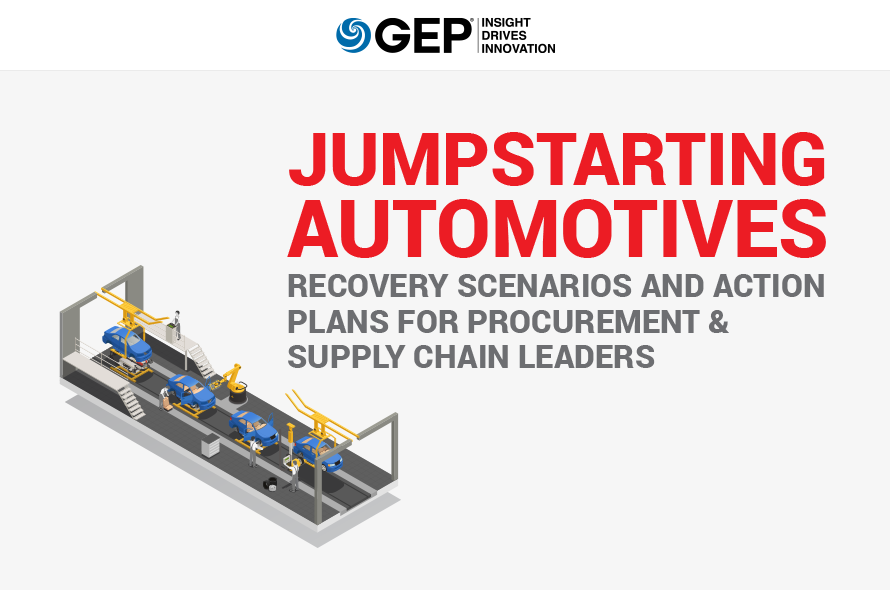The consumer crunch in the automotive industry will not last forever. Despite the unfortunate pandemic, automakers — and every ancillary business around it — have to plan for economic recovery.
And you need to do it now.
But how do you plan if you don’t know what kind of recovery it will be?
Our newest GEP BULLETIN, Jumpstarting Automotives: Recovery Scenarios and Action Plans for Procurement & Supply Chain Leaders, details every possible scenario quickly and succinctly so your company can rapidly put recovery efforts in place today — for tomorrow.
What’s Inside:
- Plans for V-, U- or L-shaped economic recovery
- Specifics on risk, resilience, flexibility, cash flow, cycle time and more
- Guidance from two of the industry’s most-informed consultants
This bulletin is a must-read for leaders in the automotive industry right now.
The pandemic is everywhere, and no one could have foreseen a disruption that would simultaneously hit the entire ecosystem of automotive suppliers and value chain across the world.
The automotive industry’s annual turnover is equivalent to the world’s sixth largest economy with direct employment estimated at nearly 14 million workers,, according to the International Labor Organization. The industry is going through its biggest change in the last century including the shift to electrification, autonomous vehicles and shared driving.
As if this was not enough, the current COVID-19 crisis adds a triple whammy for all the participants in the industry – vehicle manufacturers, suppliers, dealers, aftermarket retailers, and more – as supply chain and manufacturing disruptions promulgate and consumers show reluctance to spend their limited cash on large ticket discretionary items, such as cars.
COVID-19 WILL CREATE A "NEW NORMAL" IN THE AUTOMOTIVE INDUSTRY
China has started to open its economy after a record 43% decline in automobile sales compared to March 2019, according to the China Association of Automobile Manufacturers. The lessons learned to date are that sales recovery will be slow and non-linear signifying a new normal.
The billion-dollar question is whether economic recovery will be V-, U- or L-shaped. We believe that all three scenarios are likely to be applicable in the automotive industry depending on your company’s position in the total value chain. Therefore, every automotive company needs to define how they will tackle the COVID-19 challenge and treat it as an opportunity to improve their supply chains across multiple dimensions — resilience, flexibility, cost competitiveness, cash position, efficiency and cycle time — while enhancing growth opportunities.
HOW TO NAVIGATE THE NEW NORMAL: ASSESS & PLAN FOR THESE SCENARIOS
The table below summarizes what automotive companies can do immediately.
| ECONOMIC SCENARIO | V RECOVERY | U RECOVERY | L RECOVERY |
| KEY RISK | Not using the current crisis to make longer term improvements | Supply base at risk due to longer recovery time to ‘normal’ volume | Supply base at risk due to volumes substantially below ‘normal’ for an extended period |
| RESILIENCE | Reassess your supply base risk especially in China and other "far" locations to see if nearshoring can help & make changes | Assess risks in your supply chain due to slower turnaround - and make changes as needed to ensure security of supply | Assess risks in your supply chain due to lower business volume - and make changes as needed to ensure security of supply |
| FLEXIBILITY | Reassess your manufacturing footprint to see if make/buy should be changed to improve operating flexibility & make changes | Reassess your manufacturing footprint to see if make/buy should be changed to improve operating flexibility & make changes | Reassess your manufacturing footprint to see if make/buy should be changed to improve operating flexibility & make changes |
| Reassess your supply base competitiveness at 80% lower run rates & change as needed | Reassess your supply base competitiveness at 80% lower run rates & change as needed | ||
| COST REDUCTION & CASH FLOW | Enhance your ability to better assess supplier costs & accelerate negotiations to make changes as needed | Enhance your ability to better assess supplier costs & accelerate negotiations to make changes as needed | Enhance your ability to better assess supplier costs & accelerate negotiations to make changes as needed |
| Trade off cash for cost reductions to improve your or your supply base's financial health in the near term | Trade off cash for cost reductions to improve your or your supply base's financial health | ||
| EFFICIENCY & CYCLE TIME | Reassess all internal processes to find ways to automate and eliminate ‘drag’ | Reassess all internal processes to find ways to automate and eliminate ‘drag’ | Reassess all internal processes to find ways to automate and eliminate ‘drag’ |
| EFFICIENCY & CYCLE TIME | Enhance your e-commerce capability for AM parts including which suppliers you get them from | Enhance your e-commerce capability for AM parts including which suppliers you get them from | Enhance your e-commerce capability for AM parts including which suppliers you get them from |
HOW GEP CAN HELP
GEP has worked with several automotive companies across the value chain. Our assessment and implementation approaches and methodologies enable clients to realize sustainable value. For example, we recently helped an automotive OEM reduce their purchased costs by over 15% while improving the organization’s responsiveness.
RAPID RESPONSE SOLUTIONS FROM GEP
As the coronavirus crisis intensifies, managing your supply chain is going to get even more challenging. It may be worth finding a partner with deep experience in procurement and supply chain management to reinforce your capabilities and help you stay on course.
If you would like to have a conversation about how we can help, please reach out to our supply chain leadership.

Krish Vengat N
Vice President, Consulting, GEP
Krish is a seasoned procurement and supply chain management professional proficient at delivering sustainable cost savings and process improvements across industries. He has been a part of multiple procurement transformation initiatives, led several large-scale strategic sourcing engagements, and secured around a billion dollars of savings in both direct- and indirect-related spend and supply chain operations. His clients include Fortune 500 companies, primarily in CPG, automotive, and industrial manufacturing.

C V Ramachandran
Senior Consultant, GEP
Prior to helping GEP build out its Automotive and Industrial Manufacturing practice, CV served as Senior Managing Director at Accenture for Daimler, Scientific Games, an autonomous electric vehicle start-up, Case New Holland and Lennar. Prior to that, CV held leadership positions at AlixPartners, A.T.Kearney, and Booz Allen Hamilton. Outside consulting, CV worked at Ford Motor Company and Midland Ross. He has led panel discussions at World Economic Forum sessions. CV’s functional expertise include business strategy, product development, digital transformation, procurement, cash flow management, and due diligence.

